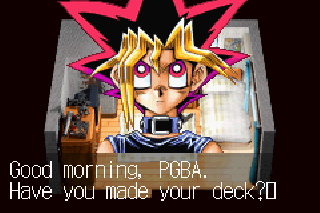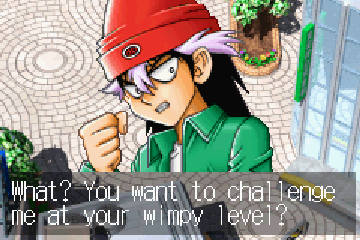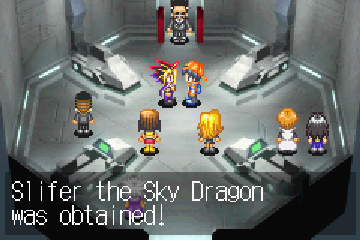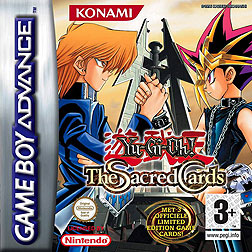Let me go ahead and preface this review by quoting a great man:
THIS GAME SUUUUUUUUUUUUUUUUUUUUUUUUUUUUUCKS!
And by Mega Ultra Chicken does it ever! Now, let’s wind the
clocks back to the early years of the 2000s.
Everyone remembers the Yu-Gi-Oh! Craze, right? I remember it, you
remember it, everyone. And, of course,
with a massive anime cash cow comes merchandising! But even the almighty Yogurt
himself would facepalm at the sheer and utterly ridiculousness that is “Yu-Gi-Oh! The Sacred Cards”. Brought up by the hands of Konami and
Nintendo from some deep pit of the Hells, you would think that this would be an
utterly harmless adaptation of children’s card games.
You would be wrong.
So very, very wrong.
 |
| Now, Yugi, your precious screen time is mine! |
The game picks up at the beginning of the Battle City arc
from the anime (I’ve not read the manga, though as I understand it, the same
thing applies). You are the not at all
looking like a Pokémon trainer friend of Yugi Muto and Joey Wheeler and you are
set to compete in the Battle City tournament and…yeah, it’s a self-insert
fanfic of Season 2. Really, in just a
completely unashamed way. Stand aside Yugi Muto, it is now [Insert Player Name
here] who will battle the forces of darkness and save the world from complete
and utter destruction!
This is kind of just wrong within an established media, as
it basically sees the main characters reduced to background as they parade
around in your wake singing your praises. And while that might work just fine
in some original IP, playing this game with any knowledge of the “Yu-Gi-Oh!”
franchise just makes you feel a bit too much like a Mary Sue…or at least it would if you were actually on par with
the characters in the anime.
I’ve heard people complain that this game is far too easy,
and to an extent I agree. However,
that’s only if you’re willing to play into the two major mechanics that the
game forces upon you – Deck Capacity and Attribute Rock-Paper-Scissors.
Now, in a standard game of Yu-Gi-Oh! (or in this case, it’s
in-universe equivalent “Duel Monsters”), if two monsters battle, the one with
the highest attack points wins (baring effects or other cards getting
involved). And while that might be the case in Sacred Cards, the
uninitiated are going to be very, very pissed when their “Meteor Black Dragon”
is defeated in a single blow by a “The Unhappy Maiden”.
Why? Attributes.
As I stated above, this game actually brings attributes into
play. While some of them, I admit, do
make sense – such as light being defeated by Shadow – some of them make
absolutely no sense and are completely and utterly arbitrary – such as Forest
defeating Wind – and the whole system is really completely ridiculous for this
game. No one, literally no one, who bought this game would think it runs any
differently than the actual trading card game.
And while there have been other ones that follow a similar system (“Forbidden Memories” on the Playstation
One comes to mind), it was incredibly stupid and pointless there too.
Top tip for dealing with this problem, diversify your
deck. I’ve heard other people talk about
stacking your deck with certain monsters before every battle, but there are
some points in the plot where you can’t do that and are immediately thrown into
your next fight with no prep time in between – such as your battle against
Ishizu for Obelisk, followed immediately by a battle with Seto Kaiba who
challenges you for it as well, this of course creating a massive plot hole as
in the anime Kaiba already had
Obelisk before the tournament started.
 |
| Who are you again? |
Then again, this game is no stranger to plot holes. You battle not only the minor characters from
Season One that Joey battles to get into the Battle City finals, but also
Strings (making one wonder how Yugi ends up obtaining Slifer) and Bonz (making
one wonder how Bakura gets into the finals).
But hey, plot holes! Who cares? Self-insert fanfic!
But back to my original point, you diversify your deck and
make sure that you’ve got at least something
that can roll through your opponent.
This does, however, lead to a massive problem with grinding. And this, in turn, brings me to Deck Capacity
and Duelist Level. Yet another
completely arbitrary thing that the developers put in that is completely
unnecessary and that I don’t think has been in another other Yu-Gi-Oh game to
date (exempting this game’s sequel, I believe).
Basically, to be less than kind, you start out the game with
complete and utter crap. The game
assigns a number to each card, higher for higher attack monsters and easier to
summon ones, and if your Duelist Level is too low, then you can’t use that card
in your deck. How do you raise your
Duelist Level? Why, by dueling, of course!
So you get the higher duelist level and you can finally use that card,
but then you notice the “Duel Capacity” number at the top of the screen going
red, which means you’ve got too many points in your deck and thus have to start
over again. Likewise, your Duel Capacity
is increased by dueling.
 |
| His voice gives you super strength...only not... |
I really don’t
understand why this mechanic exists. To get anything decent, you have to grind incessantly. Top tip:
if you’re looking to do this, hit up Bonz in the graveyard after you
defeat him the first time. Sure, you’ll
have more Zombie cards then you will ever actually care to have, but he
increases your Deck Capacity by ten every time you duel, which is much better
than grinding against Tristan (who, for some creepy reason, is hanging around
outside your house) and gives only
five points a pop.
Nevertheless, it becomes a vicious cycle. You get a card and find that you can’t use it because your Deck Capacity isn’t high
enough. Then you duel and duel and duel and eventually you win a card that you really want to use, but find
that you can’t because your Duelist
Level isn’t high enough. So you duel and
duel and duel even more and you and find you can’t put it in your deck because
your Deck Capacity isn’t high enough.
But don’t worry, dear readers, this process has all joy and satisfaction
of your standard MMO.
…oh, yes, I can just tell
you’re overjoyed at the prospect.
There’s also more of a focus on monsters than on magic and
traps. In your starter deck, you end up
with only two Magic cards and a Trap
card. And until around the mid-point of
the game, your opponents don’t even really use Magic cards or Traps outside of
“Mooyan Curry”, so you kind of wonder why they even bothered at all. The monster focus is good, though, because it
makes the best strategy apparent, especially for later on in the
storyline: Complete annihilation.
Your opponent summons a monster, you destroy it immediately
while summoning another to attack them directly, and repeat the process until
you leave them without lifepoints and their rarest card. And that’s it, so this is really a strategy I can get behind. Another bizarre thing is that effect monsters
can only use their effects on the turn they are summoned, which creates a bit
of confusion. But it also keeps away the
fear of cards like “Man-Eater Bug” that have Flip Effects in the standard game
but are otherwise useless here.
 |
| Yep...this is nothing like Pokémon at all... |
As I said, the plot has enough holes for me to drive a
motorcycle through (whilst playing card games, no less). It’s basically Battle City, but with some
changes. For one, Yugi Muto is not the
hero of destiny who ends up battling Marik Ishtar’s Yami version, you are. After defeating the minor villain characters
that Joey defeated in the actual show (Weevil Underwood, Espa Roba, Mako
Tsunami, et al.) and some of Yugi’s (Arkana, Strings, et al.), as well as even
some of Bakura’s fair (the aforementioned Bonz), you take the place of Ishizu
in the finals after defeating her, and then Kaiba (which brings into question
how he would still be in the Tournament).
Long story short, the final duels end up being you against Yugi
and Kaiba against Marik. Unsurprisingly,
you defeat Yugi and then go on to duel, of all people, Marik (who would have
guessed?)! By this time, however, you have both Obelisk and Slifer, so this
duel should be a piece of cake, right?
Wrong.
Now, don’t get me wrong, if you follow the strategy as
listed above, you should be fine. Do not, for any reason, allow Marik to get
three monsters on the field or he will
summon the Winged Dragon of Ra. And
thanks to the giant God Chicken’s ability, it’s an OTK every time.
But nonetheless, you defeat Marik and break destiny into a
million tiny little pieces…and then Ishizu asks you to give back the Egyptian
God cards so she can seal them away again.
Umm…why?
She didn’t make Yugi do it in Season 2, why would she do it
to me? Oh, because I’m not the mystical Pharaoh of Legend and thus can’t handle
their combined strength? Oh, please! If
you’re putting this up as a self-insert fanfic bonanza, you really shouldn’t
avert the trope now! At the ending of all places!
But in the end, this game really isn’t worth it. Grinding for a few hours and then pummeling
your enemies into submission does not show skill, it shows OCD. It’s easy, yes, but only if you’re willing to
go the World of Warcraft route and level up to use cards, thereby getting new cards and leveling up to use those
cards, and so on and so forth until you can pretty much just walk through everyone.
You’re either bored by how easy it is or
burned out by all the grinding, and either way I’m pretty sure that this game
is not good. And I’m especially sure you’d get more enjoyment
by setting the game cartridge on fire.
"Yu-Gi-Oh! The Sacred Cards" is available from Konami for the Nintendo Game Boy Advance.
"Yu-Gi-Oh! The Sacred Cards" is available from Konami for the Nintendo Game Boy Advance.

No comments:
Post a Comment